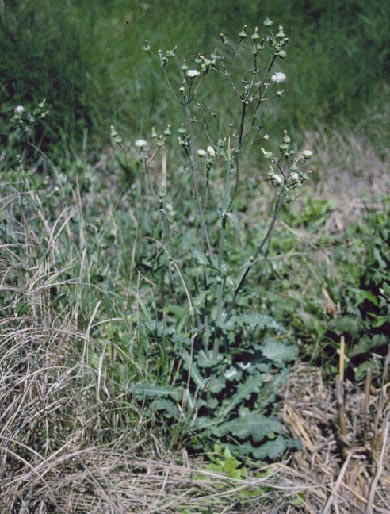Description
Taxonomy
| Kingdom | Phylum | Class | Order | Family | Genus |
|---|---|---|---|---|---|
| Plantae | Magnoliophyta | Magnoliopsida | Asterales | Asteraceae | Sonchus |
Synonyms
Invasion History
Chesapeake Bay Status
| First Record | Population | Range | Introduction | Residency | Source Region | Native Region | Vectors |
|---|---|---|---|---|---|---|---|
| 1874 | Established | Stable | Introduced | Boundary Resident | Europe | Eurasia | Agriculture(Agricultural Weed),Shipping(Dry Ballast),Natural Dispersal(Natural Dispersal) |
History of Spread
Sonchus asper (Spiny Sow-Thistle) is a native of Eurasia, and is now widespread in North and South America, South Africa, Australia, and New Zealand (Swedish Natural History Musem 2001). Early occurrences in North America may have been overlooked, due to confusion with the similar, also introduced, S. oleracea (Smooth Sow-Thistle). Sonchus asper had been regarded as a variety of the latter species by some botanists (Torrey 1843). The earliest record which we have found is 'salt marshes' near New York (Torrey 1826). This plant is a widespread agricultural weed, but could also be transported by dry ballast, since S. arvensis (Field Sow-Thistle) was found in ballast piles in New York (Brown 1878). Sonchus asper is now a widespread weed of 'waste places, roadsides, etc.' (Fernald 1950) and cultivated ground, and is found in all 50 U.S. states (Agricultural Research Service 1971; Natural Resources Conservation Service 2001).
In the Chesapeake Bay region, the first record of Sonchus asper which we have is a collection from the 'Potomac Flats' in Washington DC in 1874 (Potomac-Side Naturalists' Club 1876; U.S. National Herbarium collections). This plant now occurs throughout MD (Brown and Brown 1984) and in most VA counties (Harvill et al. 1992). Most available records are terrestrial, but Tatnall (1946) described the habitat as: “fields, waste ground, and sands of the seashore'. Sonchus asper was common, at the upper edge of brackish marshes and strandlines in Shady Side and on strandlines at Rose Haven MD, in October 2000 (Fofonoff, personal observations).
References- Agricultural Research Service 1971; Brown 1878; Brown and Brown 1984; Fernald 1950; Fofonoff, personal observations; Harvill et al. 1992; Potomac-Side Naturalists' Club 1876; Swedish Natural History Musem 2001; Tatnall 1946; Torrey 1826; Torrey 1843; Natural Resources Conservation Service 2001; U.S. National Herbarium collections
Invasion Comments
Ecology
Environmental Tolerances
| For Survival | For Reproduction | |||
|---|---|---|---|---|
| Minimum | Maximum | Minimum | Maximum | |
| Temperature (ºC) | ||||
| Salinity (‰) | 0.0 | 0.0 | ||
| Oxygen | ||||
| pH | ||||
| Salinity Range | fresh-meso |
Age and Growth
| Male | Female | |
|---|---|---|
| Minimum Adult Size (mm) | ||
| Typical Adult Size (mm) | ||
| Maximum Adult Size (mm) | ||
| Maximum Longevity (yrs) | ||
| Typical Longevity (yrs |
Reproduction
| Start | Peak | End | |
|---|---|---|---|
| Reproductive Season | |||
| Typical Number of Young Per Reproductive Event |
|||
| Sexuality Mode(s) | |||
| Mode(s) of Asexual Reproduction |
|||
| Fertilization Type(s) | |||
| More than One Reproduction Event per Year |
|||
| Reproductive Startegy | |||
| Egg/Seed Form |
Impacts
Economic Impacts in Chesapeake Bay
Sonchus asper (Spiny Sow-Thistle) is a widespread weed in disturbed areas in the Chesapeake Bay watershed, but its economic impacts in tidal wetlands are unknown.
Economic Impacts Outside of Chesapeake Bay
Sonchus asper (Spiny Sow-Thistle) is a widespread agricultural weed in the U.S. (Natural Resources Conservation Service 2002) and elsewhere, but its economic impacts in tidal wetlands are unknown.
References: Natural Resources Conservation Service 2002
Ecological Impacts on Chesapeake Native Species
Sonchus asper (Spiny Sow-Thistle) is a widespread weed in disturbed areas in the Chesapeake Bay watershed, but its impacts on native biota in tidal wetlands are unknown.
Ecological Impacts on Other Chesapeake Non-Native Species
Sonchus asper (Spiny Sow-Thistle) is a widespread weed in disturbed areas in the Chesapeake Bay watershed, but its impacts on exotic biota in tidal wetlands are unknown.
References
Agricultural Research Service (1971) Common weeds of the United States., In: (Eds.) . , Washington, D.C.. Pp.Brown, Addison (1878) Plants introduced with ballast and on made land., Bulletin of the Torrey Botanical Club 5: 255-258
Brown, Melvin L.; Brown, Russell G. (1984) Herbaceous Plants of Maryland, , College Park. Pp.
Fernald, Merritt L. (1950) Gray's Manual of Botany, In: (Eds.) . , New York. Pp.
Gleason, Henry A. (1963) The new Britton and Brown illustrated flora of the northeastern United States and adjacent Canada, In: (Eds.) . , New York. Pp.
Gleason, Henry A.; Cronquist, Arthur (1991) Manual of vascular plants of northeastern United States and adjacent Canada, In: (Eds.) . , Bronx, New York. Pp.
Harvill, A. M.; Bradley, Ted R.; Stevens, Charles E.; Wieboldt, Thomas F.; Ware, Donna M. E.; Ogle, Douglas W.; Ramsey, Gwynn W.; Fleming, Gary P. (1992) Atlas of the Virginia Flora, , Burkeville, VA. Pp.
1997-2024 USDA PLANTS Database.. Onine databse
Tatnall, Robert R. (1946) Flora of Delaware and the Eastern Shore, , Wilmington. Pp.
Torrey, John (1823) A flora of the north and middle sections of the United States, , New York. Pp.
Torrey, John, M.D. (1843) Flora of the State of New York, 2 , Albany. Pp.
Torrey, John, MD. (1843) A Flora of the state of New York, In: (Eds.) . , Albany. Pp.
